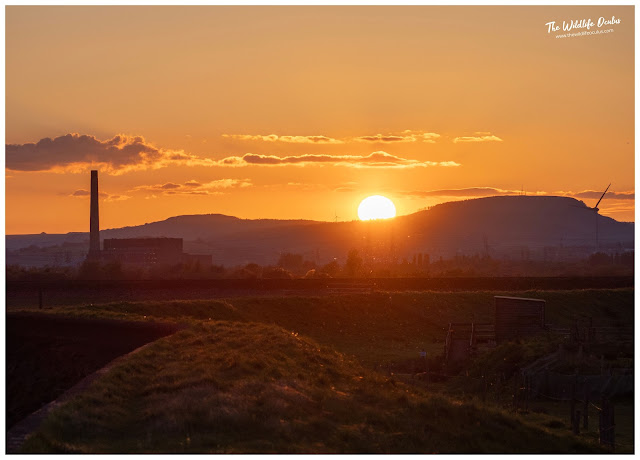Gold dust at sunset
 |
| "Gold Dust" at Goldcliff Lagoons - millions of airborne insects dance in the evening sunlight. Spider webs cover the grass. |
This bank holiday weekend we at last have had some good weather and I had the time to visit Goldcliff Lagoons in the evening for a sunset.
On Saturday evening I had the nature reserve pretty much to myself. The tide was out and the lagoons were fairly quiet. I think apart from some of the breeders ( Avocets, Lapwings and Redshank) the lagoons were quiet and the huge Black-Tailed Godwit flock was absent.
It was gloriously sunny and warm for a change during this visit. A welcome change as it has been like a mud bath for months, due to the incredible amount of rain we have had. Getting into Hide 1 remains like a Mission Impossible challenge as you have to walk over some wooden planks to avoid face planting in a quagmire.
During the evenings at Goldcliff its really hard work to see anything from the first two hides and the platforms. The sun being low in the sky is fierce on the eyes and even when wearing sun glasses any bird life on the Monks and Priors Lagoon is silhouetted.
After squinting out from Hide 1 I decided to make my way to the seawall and enjoy the evening sunshine and have a chill out.
From the vantage point of the seawall I could admire the expansive foreshore mud that had been revealed by the retreating tide.The estuary was becalmed and there was hardly a breath of wind. As soon as my head popped up over the seawall I heard the distinctive call of a Whimbrel. I scanned the mud and sure enough there was a Whimbrel roosting on one leg. It was calling to two other Whimbrels who had taken flight and I watched them head off around Goldcliff Point.
 |
| Whimbrel on the foreshore. It was a little sleepy. |
Whimbrels are a long distant migrant. These waders winter in West Africa and some as far south as South Africa. I always marvel at how many species of migrant birds visit Goldcliff in Newport. This particular bird I think was having a well earned nap.
Further out was a small flock of Black-Tailed Godwits feeding at the edge of the water. I then noticed a solitary Avocet feeding along the shoreline. On looking closer at it I saw that it had two red colour rings on its legs , both marked with "H9", I have seen this bird previously - see more here.
 |
| Colour ringed Avocet H9 |
I must admit as sunset approached I was tired and had to have a lie down on the seawall. My day had started at 4.30 am when I had set out to do my BTO BBS survey in Pontypool ( more on a separate blog post) so the days activities were catching up on me at last.
I can't think of many better ways myself than basking in the warm evening sunshine on the sea wall at my favourite nature reserve in the world.
As I relaxed and watched the world go by nature decided to come to me. I heard Whimbrels calling and first one landed on the seawall and two others flew over me and landed on the grass about twenty meters away.
 |
| A pair of Whimbrels join me near the seawall. |
The sun was getting much lower now and the first Whimbrel was very difficult to see in the glare of the sun, whilst the pair on the grass were illuminated in lovely golden light. They seemed quite content and relaxed. They knew where I was and saw me as no threat as long as I kept myself to myself and did not approach them.
I prepared my cameras for the inevitable sunset. Looking down the seawall and towards Uskmouth the air above the wall was glittering with what appeared to be gold dust. Millions of airborne insects were reflecting the golden light of the sun. They sparkled as they flittered in the rays of the sun.
 |
| A Whimbrel becomes the latest member of the Goldcliff Wall of Fame club. |
The grass on the sea wall was covered in fine golden gossamer threads. Spiders were taking advantage of the explosion of insect life and had spun webs all over the grass to catch their prey.
It was an amazing spectacle to watch.
Then I heard a Cuckoo calling and eventually located it perched up on bush at the far end of Priors Lagoon near the fence line. I wont post my picture its the worst record picture ever.
A disturbance over the lagoons suddenly caught my attention and I turned to see a female Marsh Harrier causing havoc. Avian alarm calls rang out all over the reserve. Panic was everywhere. The Marsh Harrier quartered Priors lagoon and a small flock of Tufted ducks exploded into the air and sped away from the following raptor in mad panic.
 |
| A female Marsh Harrier tries her luck with the Tufted Duck flock. |
Then as quick as it had all started a calmness came over the reserve. The sunset was upon us. A fiery disc was descending now, low on the horizon it would soon go down behind the mountains on the Western horizon.
 |
| Sunset. |
I lived the moment and stood and stared in wonder. The day was done and I had a lovely feeling of completeness and satisfaction.
Today had been a good day :)





Comments
Post a Comment